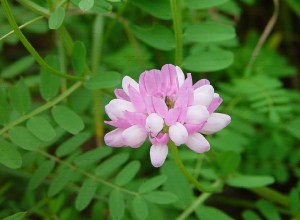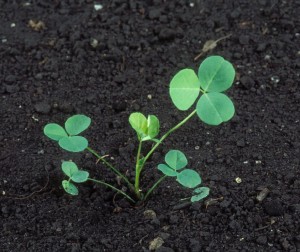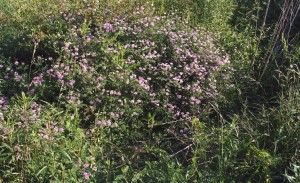Crown Vetch
Securigera varia (Coronilla varia)
Crown Vetch
Native Origin: Native to Central and Southern Europe, crown vetch was introduced by the U.S. Department of Agriculture in the 1950s for planting on slopes as erosion control. Widely used along roadways, it was seeded across the country during the expansive construction of the Interstate Highway system and its subsidiary roadway improvements. Crown vetch also produces high quality fodder for livestock –excepting horses, which can be poisoned by eating it in large quantities and for deer and elk. Since it aids nitrogen fixation in soil, crown vetch also has been planted for mine reclamation and as a green manure cover crop.
Description, Habitat & Ecological Impact: A member of the Pea family, crown vetch has attractive blossoms, ranging in color from deep pink, to white, to violet, on umbels on long stalks. Flowering occurs from early summer into autumn with narrow, flattened seedpods produced. The dark green leaves as compound with nine to 25 leaflets per leaf. Crown vetch reproduces both by seed and vegetatively. Creeping stems can reach over six feet and rhizomes may grow to 10 feet long, enabling plants to quickly spread out and cover large areas. One plant can stretch out and cover between 70 to 100 square feet within four years.
Tolerant of a wide variety of growing conditions and soil types, crown vetch grows best and reproduces at high rates in open sunny sites. Natural areas, particularly prairies, glades and open woodlands, can be very quickly degraded by crown vetch as it out competes native grasses and flowers, turning once richly diverse plant and animal communities into a singly species desert. Crown vetch can and has successfully colonized and overtaken even well established tallgrass prairies. And, even after control measures reduce or eliminate crown vetch from an area, the natural soil processes and nutrient cycles remain altered due to the plants’ nitrogen-fixing capabilities.
Manual Controls: Very small areas can be controlled by manual pulling, taking care to remove all parts and roots; several years of monitoring and repeated removal are needed as remaining seeds continue to sprout. Repeated mowing and/or prescribed burning will work on small areas but will not control large populations.
Chemical: Systemic herbicides such as glyphosate (Roundup), triclopyr (Garlon) and others used at the recommended rates can be effective. Mowing prior to application, to reduce plant mass, can increase herbicide effectiveness. Chemical control in early spring, prior to flowering and seed dispersal, will reduce but not eliminate need for follow-on monitoring and control. Repeat applications of herbicide during the initial year and in follow-on years generally are required, as seeds remain viable for several years.
Comments are currently closed.



